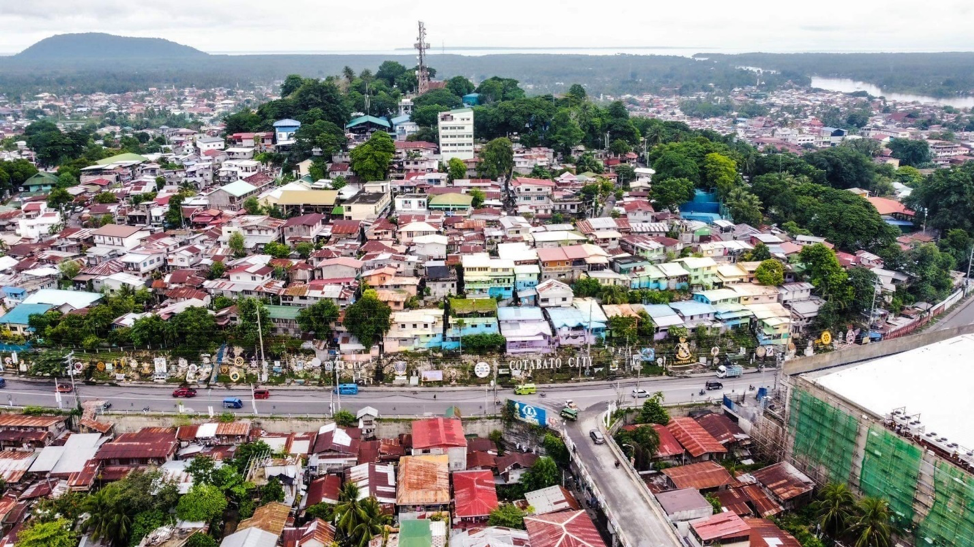
The aerial view of the Pedro Colina (PC) Hill in Cotabato City. (Marhom Ibrahim/BIO)
Cotabato City, dubbed the “Crown Jewel” of the Bangsamoro region, has weathered the test of time. It stands not only as the regional center of the Bangsamoro but also of Central Mindanao. The city has become a vibrant melting pot of diverse cultures, ethnicities, and religions.
Home to over 320,000 residents, Cotabato City is divided into 37 barangays, primarily clustered within Tamontaka, Kalanganan, Rosary Heights, Poblacion, and Bagua.
Although it is not one of the biggest cities in the Philippines, most Cotabateños still struggle and remain unfamiliar with the barangays in this city. Native to the place or not, it is undeniable that addresses can be confusing sometimes.
I know right! You can’t be the only one who struggles with the delivery addresses.
Well, fret no more! To help you conquer confusing delivery addresses, here’s a brief guide exploring the city’s barangays through their famous landmarks.

This is the Immaculate Conception Parish Church of Tamontaka, the oldest church in Cotabato City. (Hamdan Badrudin/BIO)
Barangay Tamontaka
Barangay Tamontaka is well-known as a hub for the earliest Spanish settlements, bringing the Christian religion into the city. It also features farms and swamps, where most of the city’s rice production takes place, as well as the 230-meter-long Tamontaka Bridge.
This barangay is divided into six—Tamontaka Mother Barangay (MB) and Tamontaka 1 to 5—and has a total population of 14,099, based on the data of the Philippine Statistics Authority (PSA).
| Barangay | Landmark |
| Tamontaka MB | Tamontaka Church |
| Tamontaka I | Turkish Orphanage |
| Tamontaka II | Diversion Road, Cynthia Village |
| Tamontaka III | Pagalamatan |
| Tamontaka IV | Lisbong |
| Tamontaka V | Tiogon/Margues (Boundary of Tamontaka and Mother Kabuntalan, Maguindanao del Norte) |

Sultan Hassanal Bolkiah Masjid, popularly known as the “Grand Mosque,” is the biggest praying place of the Muslims in the BARMM. (Marhom Ibrahim/BIO)
Barangay Kalanganan
In Barangay Kalanganan, there are about 16,366 residents—equivalent to 5.05 percent of the city’s total population. Popular here is Timako Hill which lies along the coast and is home to several species like monkeys. It is also known for various fish ponds with a wide variety of seafood including mud crabs for Cotabateños and even tourists can enjoy.
| Barangay | Landmark |
| Kalanganan MB | Kapimpilan/Bucana |
| Kalanganan I | Darping |
| Kalanganan II | Bubong, Grand Mosque Path |

This is the Office of the Chief Minister (OCM) of the Bangsamoro Autonomous Region in Muslim Mindanao (BARMM). (Marhom Ibrahim/BIO)
Barangay Rosary Heights
Out of all the major clusters of Cotabato City, Barangay Rosary Heights (RH) has the largest number of barangays—a total of 14 barangays—with more than 15,000 residents.
Most “city-life endeavors” are experienced here, especially since two major malls, City Mall Cotabato and the Mall of Alnor, are located in this area, with other commercial establishments under construction.
| Barangay | Landmark |
| MBRH | Balikatan, City Health, Ramon Rabago St. |
| RH I | Pedro Colina (PC) Hill |
| RH II | Dapdap, KCC Mall, Notre Dame University (NDU)/College |
| RH III | Nayon Shariff |
| RH IV | Luna |
| RH V | Telecom, ABS-CBN |
| RH VI | Krislamville |
| RH VII | Bangsamoro Government Center (BGC), Office of the Chief Minister (OCM) Bldg., Albert Einstein School, Gonzalo Javier St. |
| RH VIII | ND Village High School |
| RH IX | Mall of Alnor, ORC/Village |
| RH X | Malagapas, People’s Palace |
| RH XI | San Pablo, Peñafrancia |
| RH XII | Rojas Elementary School |
| RH XIII | Kimpo |

Several Cotabateños are seen at the facade of the city’s Mega Market. (Hamdan Badrudin/BIO)
Barangay Poblacion
Second to Rosary Heights with the most barangays, Brgy. Poblacion has a total of 10 barangays with 21,579 residents, making up 6.64 percent of the total population of Cotabato City.
This is recognized as the place for some of the historical trade centers, including ports and markets. Most of the pioneering businesses are located in this area.
| Barangay | Landmark |
| Poblacion Mother | Super, Buliao |
| Pob. I | Ruben S. (RS) Buan, Chinese |
| Pob. II | Bahay Maria |
| Pob. III | Abe Road, Manangs |
| Pob. IV | Dela Vida College, Tamse Rd. |
| Pob. V | Jose Lim Sr. Sreet |
| Pob. VI | Washington |
| Pob. VII | Tukananes |
| Pob. VIII | Kakar |
| Pob. IX | Biniruan |

These are among the residential houses in Barangay Bagua, Cotabato City. (Hamdan Badrudin/BIO)
Barangay Bagua
Barangay Bagua is seemingly considered a “pause” location—a break from the bustle of the city proper. Commonly seen here are residential houses with over 19,987 inhabitants.
| Barangay | Landmark |
| Bagua Mother | Manday, Kampo Muslim |
| Bagua I | Lugay-Lugay |
| Bagua II | Tanghal Subdivision, “Housing” |
| Bagua III | Mabini Interior |
Cotabato City may appear to be a “small” place to wander; however, it should never be underestimated, for it only takes a single misstep to get lost in the city.
Make sure to refer to this article and never get lost again. Let this be your guide as you venture into the city of rivers and creeks—Cotabato City. (Johamin Inok)







